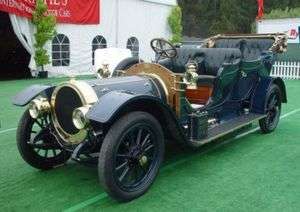Milne Barbour
Sir John Milne Barbour, 1st Baronet JP, DL (1868 – 3 October 1951) was a Northern Irish politician and baronet. As a member of the Privy Council of Northern Ireland he was styled The Right Honourable Sir Milne Barbour.
Sir Milne Barbour Bt JP DL | |
|---|---|
| Minister of Commerce of Northern Ireland | |
| In office 16 April 1925 – 16 January 1941. | |
| Minister of Finance for Northern Ireland | |
| In office 16 January 1941 – 6 May 1943. | |
| Constituency | Antrim (1921–1929) |
| Constituency | South Antrim (1929–1951) |
| Personal details | |
| Born | 1868 |
| Died | 3 October 1951 |
| Political party | Ulster Unionist Party |
| Spouse(s) | Elise Barbour |
| Children | 4 |
| Occupation | Linen manufacturer |
Background and education
Born in Lisburn, County Antrim, he was the son of John Doherty Barbour. He was educated at Elstree School, Harrow School, Brasenose College, Oxford, and Darmstadt, Germany.[1] The members of his family were wealthy linen manufacturers, owners of William Barbour Linen Thread Company of Hilden – the largest linen thread manufacturers in the world,[2] in business he was Chairman of the family company, which exists today in the same factory as Barbour Campbell Threads.[3]
Career
In politics, he served as a member of parliament for County Antrim from 1921–1929 and then for South Antrim from 1929 until his death in 1951. In 1921, he was appointed Parliamentary and Financial Secretary to the Ministry of Finance, and then entered Craigavon's Cabinet as Minister of Commerce in 1937 (where he was perceived as "wrong, inept and palsied"[4]) and was promoted, aged 72, to Minister of Finance.[4]
He also acted as High Sheriff of Armagh in 1905[5] and as High Sheriff of Down in 1907.[1] He was created a baronet, of Hilden, in the County of Antrim, on 17 August 1943.[6] He also served as President of the Belfast Chamber of Commerce in 1911, as a member of Belfast Harbour Commissioners from 1914 to 1950, as President of the Royal Victoria Hospital, Belfast and as President of the Royal Ulster Agricultural Society from 1925 to 1930 and from 1931 until his death. He also sat on the Senate of Queen's University, Belfast.[1]

Personal life
Barbour married Elise Barbour, a distant relative (b. Paterson, New Jersey, USA in 1873); Lady Barbour died at their home, Conway House, Dunmurry,[7] in 1910.[2] The couple had three daughters and one son, John Milne Jnr., whose aeroplane went missing whilst flying over the Irish sea in 1937. John was a civilian pilot (a former competitor in the King's Cup Race[8]) who would fly home at the weekends from the Barbour factory in Glasgow, where he worked during the week.[2] Barbour's sister, Helen, married Thomas Andrews, architect of the Titanic.[2] Barbour was a Freemason.[2] He was described by diarist Lillian Dean, later Lady Spender (wife of Sir Wilfrid Spender) as "a curious man who looks like a stage Mephistopheles but is given to preaching in dissenting chapels."[9] A deeply religious man throughout his life he served on as a Member of the General Synod of the Church of Ireland.[1] presented the East Window to Christ Church Cathedral, Lisburn, in memory of his wife and son.[10] The baronetcy became extinct upon his death, Barbour was predeceased by his son.[2]
Barbour Memorial Playing Fields and the Sir Milne Barbour Memorial Garden, both in Lisburn, are named in his honour.[11] A prize cup at the boat club of Queen's University, Belfast is also named in his honour.[12]
See also
References
- Northern Ireland Parliamentary Biographies
- Belfast Cathedral Archived 25 December 2007 at the Wayback Machine
- "Travel World Magazine". Archived from the original on 16 August 2007.
- Jackson, Alan A., Ireland 1798–1998: Politics and War, p.354
- "The Stormont Papers – Biography of John Milne Barbour". Retrieved 19 July 2009.
- "No. 36145". The London Gazette. 24 August 1943. p. 3794.
- Japanese Art Collections in the UK
- "Genealogy at the Linenhall by Gerry Healey". Archived from the original on 26 January 2007. Retrieved 18 August 2013.CS1 maint: BOT: original-url status unknown (link)
- Lady Spender's Diaries at PUblic Record Office of Northern Ireland
- Christ Church Cathedral, Lisburn
- "Sport Lisburn". Archived from the original on 2 June 2008. Retrieved 15 October 2007.
- Queen's University, Belfast Boat Club
| Parliament of Northern Ireland | ||
|---|---|---|
| New constituency | Member of Parliament for South Antrim 1929–1951 |
Succeeded by Brian McConnell |
| Political offices | ||
| New office | Parliamentary and Financial Secretary, Ministry of Finance 1921–1937 |
Succeeded by Alexander Gordon |
| Preceded by Edward Archdale |
Minister of Commerce 1925–1941 |
Succeeded by Sir Basil Brooke |
| Preceded by John Miller Andrews |
Minister of Finance 1941–1943 |
Succeeded by John Maynard Sinclair |
| Baronetage of the United Kingdom | ||
| New creation | Baronet (of Hilden) 1943–1951 |
Extinct |